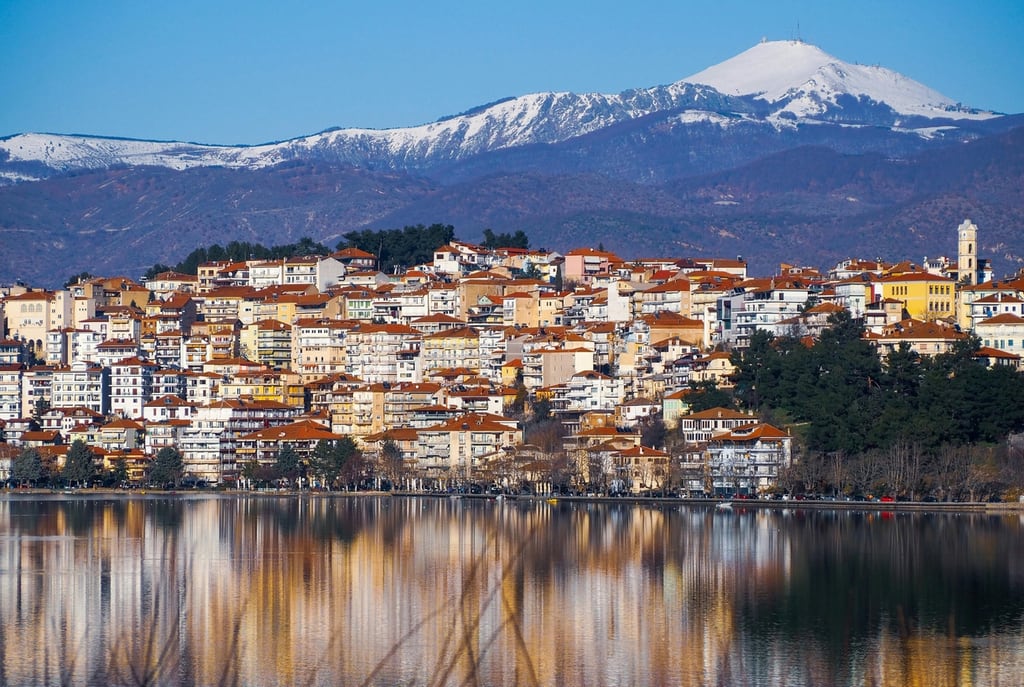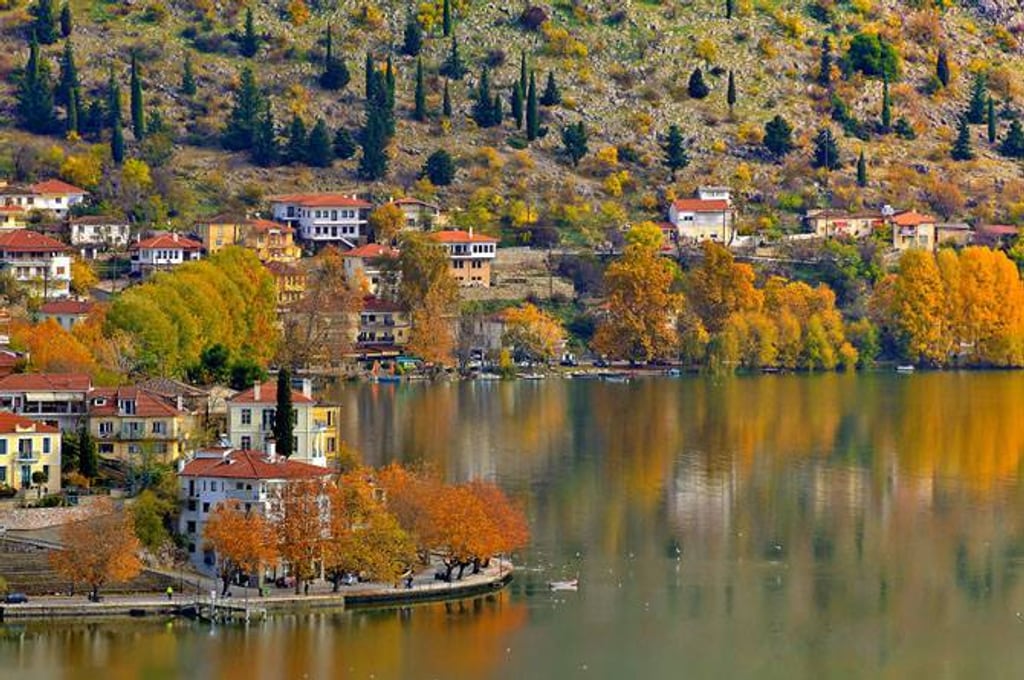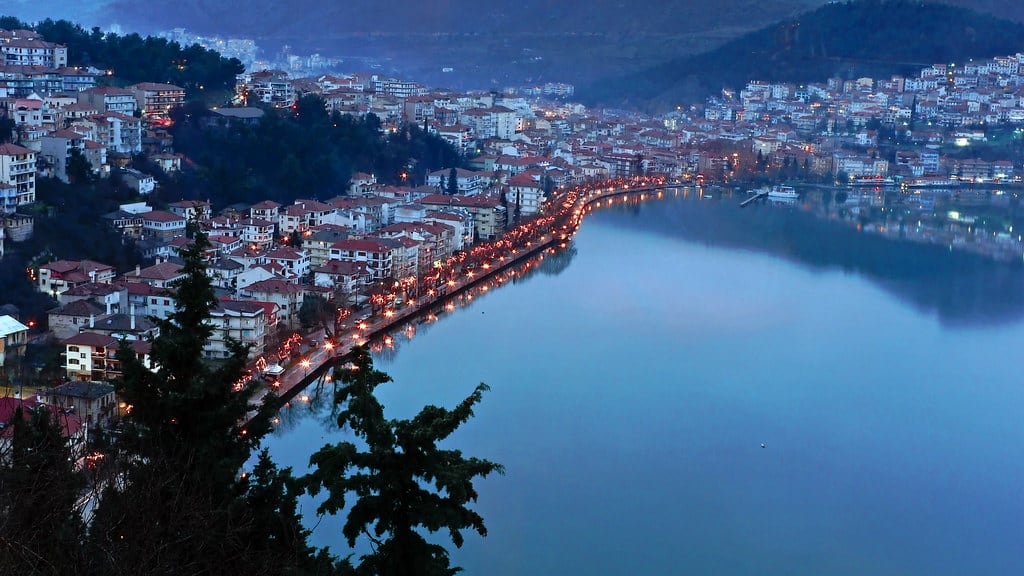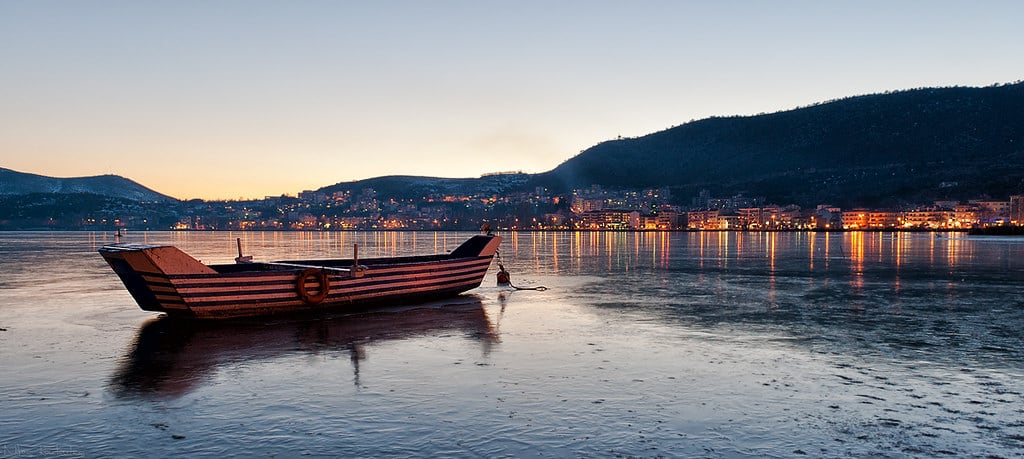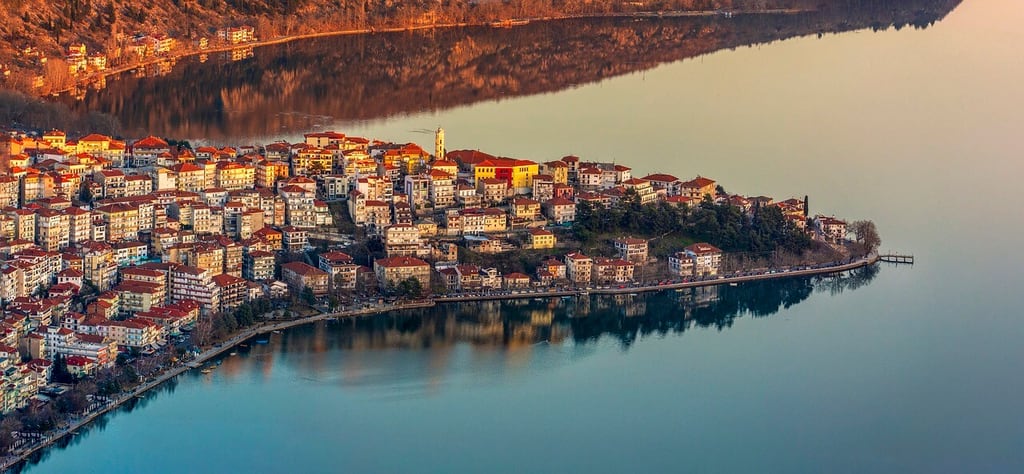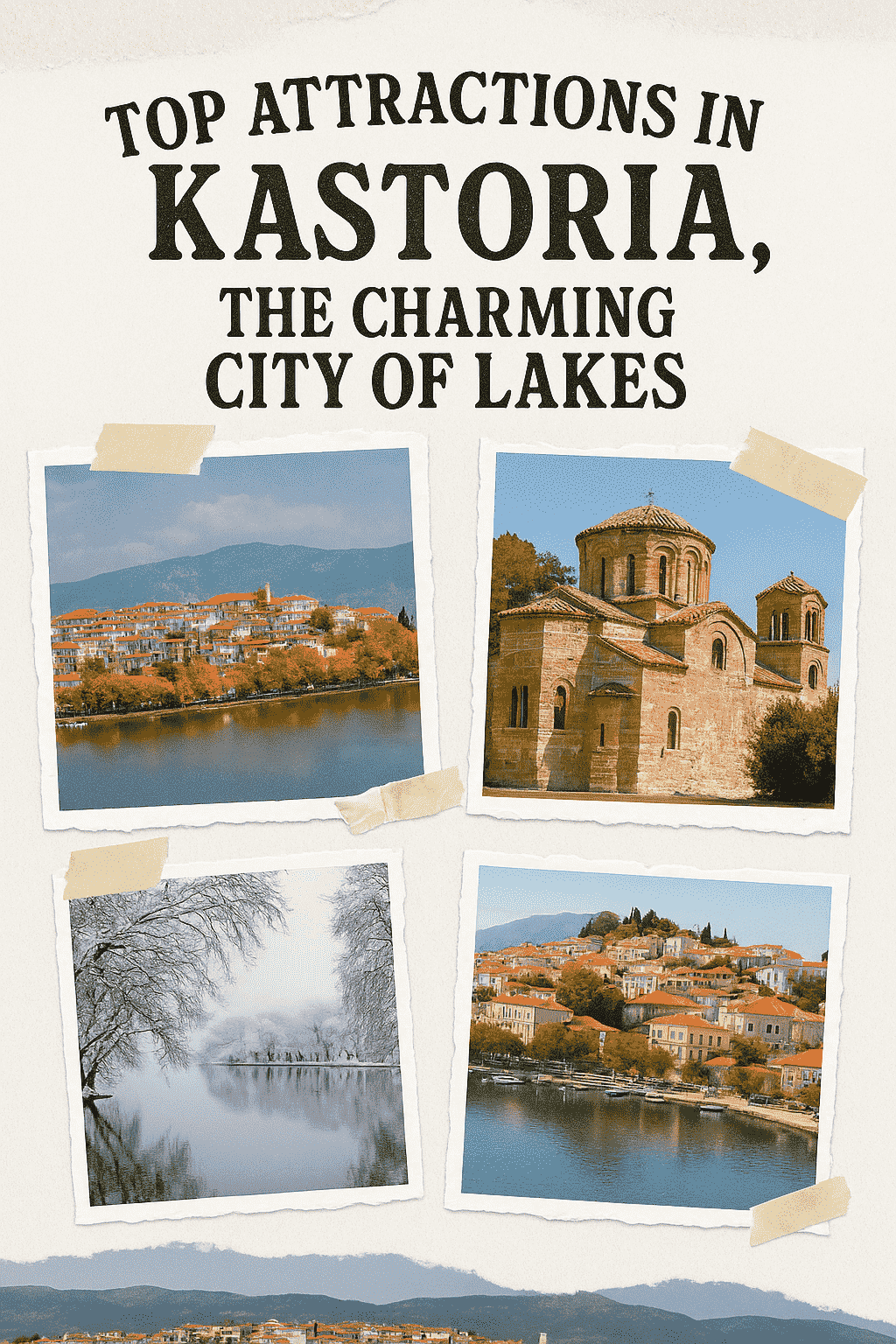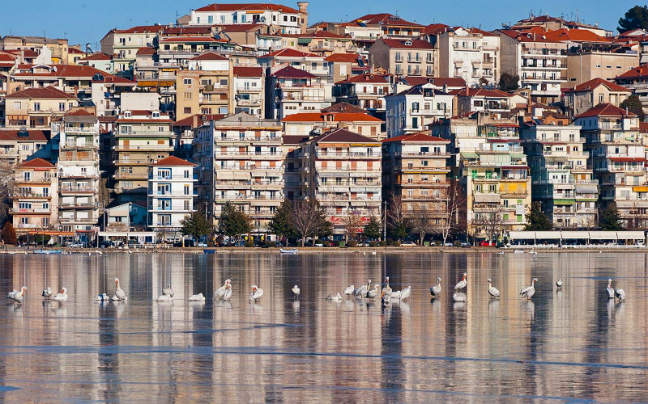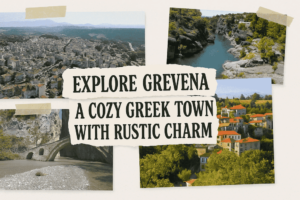Top Attractions in Kastoria, the Charming City of Lakes
Kastoria is one of those rare gems in Greece that still feels like a secret. Tucked away in the mountainous region of Western Macedonia, this lakeside town offers a beautiful combination of history, nature, and old-world charm. It’s a destination that remains under the radar for most international tourists, making it perfect for travelers who want a deeper, more authentic Greek experience. From its peaceful lake views and traditional neighborhoods to ancient monasteries and unique museums, Kastoria is a place that gently reveals its beauty to those who take the time to explore.
Lake Orestiada – The Heart of Kastoria
Lake Orestiada, also known as Lake Kastoria, is the centerpiece of the town and possibly the most photogenic lake in Greece. Surrounded by mountains and dotted with swans and ducks, the lake offers stunning views in every season. A walk along its shores feels like stepping into a painting. Early mornings are especially magical, with the mist hanging low over the water and the sun rising over the hills. Visitors can rent a bike or just stroll along the lake path, stopping at cafes that serve coffee and local pastries with a view. The reflections of the traditional houses and domes in the water create a peaceful and romantic atmosphere.
The Old District of Doltso
One of the most picturesque parts of Kastoria is the Doltso district. This neighborhood has preserved its traditional architecture from the 18th and 19th centuries, with stone mansions, cobbled streets, and flower-filled balconies. Walking through Doltso feels like time travel. Many of the old homes have been restored and turned into boutique hotels, small museums, or cozy tavernas. This area is also great for taking photos, especially in the soft afternoon light when the colors of the buildings seem to glow. Don’t miss the local taverns here that serve traditional Kastorian dishes such as fasolia (beans), pies, and lake fish.
Panagia Mavriotissa Monastery
Located just a short drive or a lakeside walk from the town center, the Panagia Mavriotissa Monastery is one of the spiritual and historical treasures of Kastoria. Surrounded by plane trees and built right by the water, the setting is peaceful and soul-soothing. The monastery dates back to the 11th century and contains some of the oldest and most beautiful Byzantine frescoes in the region. The exterior walls are also covered with faded yet mesmerizing frescoes, something rare to see in other monasteries. The quiet ambiance of the place, combined with the lake’s presence, makes this a wonderful spot for reflection or simply a peaceful break from sightseeing.
Dragon’s Cave – Spilaio tou Drakou
This natural wonder is hidden right near the lake and offers an unexpected experience. The Dragon’s Cave, or Spilaio tou Drakou, is a network of caves filled with impressive stalactites and stalagmites, and even underground lakes. The cave has its own mythological legend involving a dragon that guarded a treasure, giving it a mysterious charm. Guided tours are available, and the lighting inside highlights the textures and formations in a magical way. It’s a short visit but one that adds variety and a bit of fantasy to your Kastoria itinerary.
Kastoria’s Byzantine Churches
Kastoria is often called the city of the Byzantine churches, and for good reason. With over 70 preserved churches scattered throughout the city, some dating back as far as the 9th century, it’s a paradise for lovers of religious architecture and history. You don’t need to visit them all, but a few really stand out. Try to see the Church of Saint Stephanos with its beautiful frescoes and Saint Nicholas of Kasnitzis which has one of the most unique roof structures in Greece. These small churches are often located on quiet streets or corners, making the discovery feel intimate and personal. Each one holds a piece of the city’s spiritual and artistic legacy.
Kastoria Folklore Museum
This museum is located in a beautifully preserved mansion in the Doltso district and offers a vivid look at life in Kastoria during the 18th and 19th centuries. The rooms are set up as they would have been in a wealthy family home, complete with period furniture, embroidery, and traditional clothing. It’s not a huge museum, but it gives visitors a deep insight into Kastoria’s cultural identity, especially its connection to fur trade and local craftsmanship. The guides are friendly and passionate, often adding personal stories to the exhibits.
Kastoria’s Fur Industry and Museum
Fur trading was once the lifeblood of Kastoria’s economy, and the city still has a global reputation for high-quality fur production. The Fur Museum of Kastoria tells the story of this trade, from its historical roots to modern practices. It’s not just about fashion – the museum also explains the social and economic impact of the fur trade on the region. Even if you’re not particularly interested in fur, the craftsmanship on display is impressive, and the history behind it all is a fascinating part of Kastoria’s identity. There’s also a section dedicated to the ethical discussions surrounding fur in modern times, making it a thoughtful and balanced visit.
Byzantine Museum of Kastoria
Located in a former Ottoman-era building overlooking the lake, this museum holds a fine collection of religious icons and artifacts from the Byzantine and post-Byzantine periods. What makes the museum special is not just the artifacts, but the way they’re presented. The icons are displayed in a dimly lit space that mirrors the feeling of walking through a church. There’s a quiet reverence here that draws you into the details of each piece. The view from outside the museum is also worth noting – it’s one of the best panoramic views over the lake and town.
Kastoria Carnival – Ragoutsaria
If you’re lucky enough to visit Kastoria in early January, you’ll catch the city’s most famous festival – Ragoutsaria. This traditional carnival blends pagan roots with Orthodox customs and features music, dancing, and colorful costumes that fill the streets. Locals dress up, bands play Balkan-style music, and wine flows freely. It’s a loud, joyful, and completely unfiltered glimpse into local culture. Unlike the polished carnivals in other parts of Europe, Ragoutsaria feels authentic and rooted in community. Everyone is invited to join, and the atmosphere is one of welcome and celebration.
Boat Tours and Lakeside Cafes
For a different perspective of the town, hop on a boat tour that takes you around Lake Orestiada. The views from the water are incredible, especially in the golden hour before sunset. Some boat operators offer wine or meze onboard, making the experience even more enjoyable. After the tour, stop at one of the many lakeside cafes for a relaxed afternoon. Try a Greek coffee or a glass of tsipouro with some light snacks. The combination of fresh air, scenic views, and local hospitality creates a truly relaxing travel moment.
Shopping in Kastoria’s Local Markets
While Kastoria is known for fur, it also has lovely small markets where you can buy local products such as handmade wool, leather goods, herbs, and homemade liqueurs. The Saturday market is where locals shop for fresh produce, and it’s a great place to get a feel for everyday life in the city. You’ll also find hand-knitted socks, lace, and traditional slippers that make meaningful souvenirs. Unlike tourist-heavy places, the prices here are fair, and the sellers are happy to chat and offer advice.
Food to Try in Kastoria
Kastoria’s cuisine reflects its lake and mountain geography. Must-try dishes include grilled lake fish, bean soup (fasolada), wild mushroom pies, and slow-cooked meat with local herbs. Don’t skip the baked cheese pies, which are often handmade by elderly women following traditional recipes. For dessert, try “karydopita” (a walnut cake soaked in syrup) or spoon sweets made from local fruit. Many tavernas have outdoor seating with lake views, and prices are surprisingly affordable. A full meal with wine usually costs around 12–15 euros per person.
Day Trips from Kastoria
If you have an extra day or two, consider short trips to nearby villages like Nymfaio or Prespes Lakes. Nymfaio is a stunning mountain village known for its stone mansions and bear sanctuary. It feels almost alpine in style. Prespes Lakes, on the other hand, offer raw natural beauty, with rare bird species, small fishing villages, and a tranquil atmosphere. Both destinations are about 1.5 hours from Kastoria by car and make for perfect day escapes into nature and tradition.
When to Visit Kastoria
Kastoria is beautiful year-round, but the best times to visit are spring and autumn. In spring, the hills are green, and the weather is mild. Autumn brings golden colors and a quiet charm that suits the town perfectly. Winter is also very atmospheric, especially when there’s snow. The reflections in the lake become even more magical, and fireplaces in old mansions create a cozy vibe. Summer is less popular due to the heat, but it’s still a good time to enjoy the lake and local events.
Where to Stay in Kastoria
Accommodation options range from restored traditional mansions to budget-friendly guesthouses. If you want a romantic experience, choose one of the boutique hotels in Doltso with views over the lake. Many have wooden ceilings, vintage furniture, and homemade breakfasts served by the owners themselves. For travelers on a budget, there are also modern apartments and B&Bs that offer comfort at low prices – around 40–60 euros per night.
Final Thoughts
Kastoria is not just another pretty lakeside town – it’s a living museum of Greek culture, history, and hospitality. It offers a travel experience that feels both intimate and enriching. Without crowds or pretensions, it quietly invites you in and leaves a lasting impression. Whether you’re wandering through its ancient churches, watching the mist roll over the lake, or sharing a glass of tsipouro with a local, Kastoria will make you feel like you’ve discovered something truly special.



